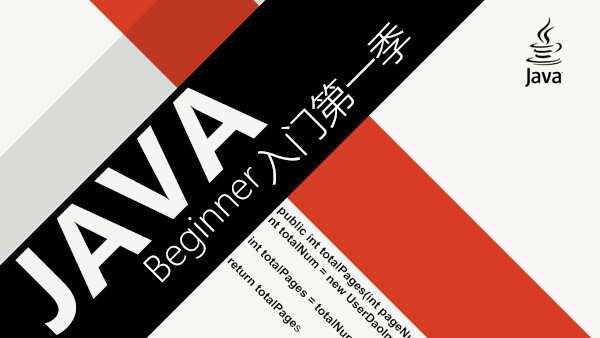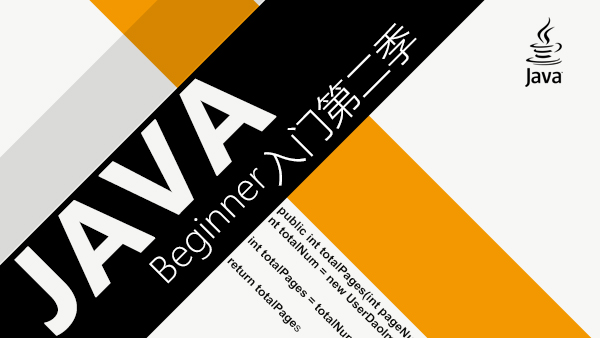JavaSE项目实战是新手入门和初级开发者掌握Java编程技能的重要途径,本文详细介绍了JavaSE的基础概念、环境搭建以及核心语法解析。文章还深入讲解了面向对象编程、常用类库的使用,并提供了项目实战入门与进阶的具体案例,帮助读者更好地理解并应用JavaSE。
JavaSE项目实战:新手入门与初级教程 JavaSE基础概念与环境搭建Java简介
Java是一种广泛使用的、跨平台的编程语言,由Sun Microsystems(现为Oracle Corporation)开发。Java的设计目标包括:
- 简单性:Java语言简洁明了,易于学习。
- 面向对象:Java支持面向对象编程(OOP)。
- 跨平台性:Java程序可以在任何安装了Java虚拟机(JVM)的平台上运行。
- 安全性:Java提供了许多安全功能,以保证程序的安全性和稳定性。
- 可移植性:Java源代码可以在不同操作系统下运行,无需重新编译。
Java开发环境安装
环境变量配置
完成JDK安装后,需要设置环境变量。在Windows系统中,可以通过系统属性中的“环境变量”设置JAVA_HOME和Path。
- 设置
JAVA_HOME指向JDK的安装路径。 - 将
%JAVA_HOME%\bin路径添加到系统Path变量中。
验证安装
打开命令提示符(CMD),输入java -version,如果显示了Java版本信息,说明安装成功。
第一个Java程序:Hello World
示例代码
public class HelloWorld {
public static void main(String[] args) {
System.out.println("Hello World!");
}
}
``
#### 编译和运行程序
1. **编译程序**
- 打开命令提示符,导航到包含`HelloWorld.java`的目录。
- 输入`javac HelloWorld.java`编译程序。
2. **运行程序**
- 输入`java HelloWorld`运行程序,输出`Hello World!`。
## JavaSE核心语法解析
### 数据类型与变量声明
#### 基本数据类型
- **整数类型**
- `byte`:8位整数,范围:-128 到 127。
- `short`:16位整数,范围:-32768 到 32767。
- `int`:32位整数,范围:-2147483648 到 2147483647。
- `long`:64位整数,范围:-9223372036854775808 到 9223372036854775807。
- **浮点类型**
- `float`:32位浮点数,范围:±1.4E-45 到 ±3.4028235E+38。
- `double`:64位浮点数,范围:±4.9E-324 到 ±1.7976931348623157E+308。
- **字符类型**
- `char`:16位Unicode字符,范围:'\u0000' 到 '\uFFFF'。
- **布尔类型**
- `boolean`:表示布尔值,只有`true`和`false`两个值。
#### 变量声明
变量声明的语法格式为:
```java
variableType variableName = initialValue;示例代码:
public class DataTypeExample {
public static void main(String[] args) {
byte b = 127;
short s = 32767;
int i = 2147483647;
long l = 9223372036854775807L;
float f = 3.14f;
double d = 3.1415926;
char c = 'A';
boolean bool = true;
System.out.println("byte: " + b);
System.out.println("short: " + s);
System.out.println("int: " + i);
System.out.println("long: " + l);
System.out.println("float: " + f);
System.out.println("double: " + d);
System.out.println("char: " + c);
System.out.println("boolean: " + bool);
}
}流程控制语句
if语句
- if语句
if (condition) { // 执行代码 } - if-else语句
if (condition) { // 执行代码 } else { // 执行其他代码 } - if-else if语句
if (condition1) { // 执行代码1 } else if (condition2) { // 执行代码2 } else { // 执行其他代码 }
switch语句
switch (expression) {
case value1:
// 执行代码1
break;
case value2:
// 执行代码2
break;
default:
// 默认执行代码
}循环语句
- for循环
for (initialization; condition; update) { // 执行代码 } - while循环
while (condition) { // 执行代码 } - do-while循环
do { // 执行代码 } while (condition);
示例代码:
public class ControlFlowExample {
public static void main(String[] args) {
int num = 5;
if (num > 0) {
System.out.println("num is positive");
} else if (num < 0) {
System.out.println("num is negative");
} else {
System.out.println("num is zero");
}
switch (num) {
case 0:
System.out.println("num is zero");
break;
case 1:
System.out.println("num is one");
break;
default:
System.out.println("num is other");
}
for (int i = 0; i < 5; i++) {
System.out.println("i is " + i);
}
int j = 0;
while (j < 5) {
System.out.println("j is " + j);
j++;
}
int k = 0;
do {
System.out.println("k is " + k);
k++;
} while (k < 5);
}
}数组与集合
数组
- 创建数组
int[] array = new int[10]; - 初始化数组
int[] array = {1, 2, 3, 4, 5}; - 访问数组元素
int firstElement = array[0];
集合
- List
List<String> list = new ArrayList<>(); - 添加元素
list.add("元素1"); - 访问元素
String firstElement = list.get(0);
示例代码:
public class ArrayAndCollectionExample {
public static void main(String[] args) {
// 数组
int[] array = new int[5];
for (int i = 0; i < array.length; i++) {
array[i] = i;
}
for (int i : array) {
System.out.println("数组元素:" + i);
}
// List
List<String> list = new ArrayList<>();
list.add("元素1");
list.add("元素2");
list.add("元素3");
for (String element : list) {
System.out.println("List元素:" + element);
}
}
}类与对象
类的定义
-
定义一个类
class Person { String name; int age; public void sayHello() { System.out.println("Hello, my name is " + name + " and I am " + age + " years old."); } } - 创建对象
Person person = new Person();
示例代码:
public class ClassAndObjectExample {
public static void main(String[] args) {
Person person = new Person();
person.name = "Tom";
person.age = 20;
person.sayHello();
}
}继承与多态
继承
-
子类继承父类
class Student extends Person { String school; public void study() { System.out.println(name + " is studying at " + school); } } - 子类对象可以是父类类型
Person person = new Student();
多态
- 方法重写
@Override public void sayHello() { System.out.println("Hello, I am a student, my name is " + name + " and I am " + age + " years old."); }
示例代码:
public class InheritanceAndPolymorphismExample {
public static void main(String[] args) {
Student student = new Student();
student.name = "John";
student.age = 22;
student.school = "ABC University";
student.sayHello();
student.study();
Person person = student;
person.sayHello();
}
}封装与抽象
封装
- 封装属性
private String name; public String getName() { return name; } public void setName(String name) { this.name = name; }
抽象类与接口
- 抽象类
abstract class Animal { abstract void makeSound(); } - 接口
interface Flyable { void fly(); }
示例代码:
public class EncapsulationAndAbstractionExample {
public static void main(String[] args) {
class Dog extends Animal implements Flyable {
@Override
public void makeSound() {
System.out.println("Bark");
}
@Override
public void fly() {
// 不实现
}
}
Dog dog = new Dog();
dog.makeSound();
dog.fly();
}
}输入输出流
文件读写
- 读取文件
File file = new File("filename.txt"); BufferedReader reader = new BufferedReader(new FileReader(file)); String line; while ((line = reader.readLine()) != null) { System.out.println(line); } reader.close(); - 写入文件
FileWriter writer = new FileWriter("filename.txt"); writer.write("Hello, World!"); writer.close();
示例代码:
public class FileIOExample {
public static void main(String[] args) throws IOException {
// 写入文件
FileWriter writer = new FileWriter("filename.txt");
writer.write("Hello, World!");
writer.close();
// 读取文件
File file = new File("filename.txt");
BufferedReader reader = new BufferedReader(new FileReader(file));
String line;
while ((line = reader.readLine()) != null) {
System.out.println(line);
}
reader.close();
}
}异常处理
抛出异常
- 抛出异常
throw new Exception("异常信息");
捕获异常
- 捕获异常
try { // 可能抛出异常的代码 } catch (Exception e) { // 处理异常 }
示例代码:
public class ExceptionHandlingExample {
public static void main(String[] args) {
try {
int a = 10;
int b = 0;
int result = a / b;
System.out.println(result);
} catch (ArithmeticException e) {
System.out.println("除数不能为0");
} finally {
System.out.println("finally块总是执行");
}
}
}日志记录
日志记录
- 使用log4j记录日志
import org.apache.log4j.Logger; import org.apache.log4j.PropertyConfigurator;
public class LoggingExample {
private static final Logger logger = Logger.getLogger(LoggingExample.class);
public static void main(String[] args) {
PropertyConfigurator.configure("log4j.properties");
logger.debug("调试信息");
logger.info("信息");
logger.warn("警告");
logger.error("错误");
logger.fatal("致命错误");
}}
示例代码:
```java
public class LoggingExample {
public static void main(String[] args) {
// 配置log4j
PropertyConfigurator.configure("log4j.properties");
// 记录不同级别的日志
logger.debug("调试信息");
logger.info("信息");
logger.warn("警告");
logger.error("错误");
logger.fatal("致命错误");
}
}项目需求分析
需求确定
- 明确目标:定义项目要解决的问题或达到的目的。
- 功能需求:确定项目需要实现哪些核心功能。
- 非功能需求:定义性能、安全性、兼容性等非功能性要求。
示例代码:
public class ProjectRequirementExample {
public static void main(String[] args) {
// 需求描述示例
System.out.println("项目目标:开发一个图书管理系统,实现图书的增删改查功能。");
System.out.println("功能需求:用户可以添加、删除、修改和查询图书。");
System.out.println("非功能需求:系统需要支持高并发访问,具备良好的稳定性。");
}
}项目架构设计
架构设计
- 模块划分:将项目分为不同的模块,每个模块负责实现特定的功能。
- 模块间通信:明确模块之间的接口和通信方式。
示例代码:
public class ProjectArchitectureExample {
public static void main(String[] args) {
// 模块化设计示例
Module1 module1 = new Module1();
Module2 module2 = new Module2();
module1.execute();
module2.execute();
}
}代码实现与调试
代码实现
- 编写代码:根据需求和架构设计编写具体的代码实现。
- 单元测试:编写单元测试用例,确保每个模块的功能正确。
示例代码:
public class CodeImplementationExample {
public static void main(String[] args) {
// 单元测试示例
TestClass test = new TestClass();
test.testMethod();
}
}调试
- 调试工具:使用IDE自带的调试工具进行调试。
- 日志记录:通过日志记录帮助查找问题。
项目优化与性能提升
代码优化
- 减少冗余代码:简化重复的代码。
- 使用高效的数据结构:选择合适的数据结构,提高性能。
示例代码:
public class CodeOptimizationExample {
public static void main(String[] args) {
// 使用高效的数据结构示例
List<String> list = new ArrayList<>();
for (int i = 0; i < 1000000; i++) {
list.add("元素" + i);
}
long startTime = System.currentTimeMillis();
for (String element : list) {
// 执行操作
}
long endTime = System.currentTimeMillis();
System.out.println("执行时间:" + (endTime - startTime) + "ms");
}
}性能分析
- 性能分析工具:使用JProfiler、VisualVM等工具进行性能分析。
- 性能瓶颈定位:定位程序中的性能瓶颈。
项目部署与维护
项目部署
- 打包项目:将项目打包为jar或war文件。
- 部署环境:选择合适的服务器和操作系统进行部署。
示例代码:
public class ProjectDeploymentExample {
public static void main(String[] args) {
// 打包项目示例
String[] args = {"-jar", "project.jar"};
// 部署环境示例
String deploymentEnv = "Tomcat 9";
System.out.println("部署环境:" + deploymentEnv);
}
}项目维护
- 代码维护:定期更新和维护代码。
- 用户反馈:收集用户反馈,不断改进产品。
实战案例分享
简单案例
- 案例描述:设计一个简单的图书管理系统,包括图书的增删改查功能。
- 需求分析:明确图书管理系统需要实现的功能和需求。
- 架构设计:定义模块划分和模块间通信方式。
- 代码实现:编写具体的代码实现。
- 调试与优化:调试代码并进行性能优化。
示例代码:
public class CaseExample {
public static void main(String[] args) {
// 简单案例:图书管理系统
BookManager bookManager = new BookManager();
bookManager.addBook(new Book("Java编程实战", "作者1"));
bookManager.removeBook("ISBN1");
bookManager.updateBook("ISBN2", "新书名");
bookManager.listBooks();
}
}复杂案例
- 案例描述:设计一个复杂的电商系统,包括商品管理、订单管理、用户管理等功能。
- 需求分析:明确电商系统需要实现的功能和需求。
- 架构设计:定义模块划分和模块间通信方式。
- 代码实现:编写具体的代码实现。
- 调试与优化:调试代码并进行性能优化。
示例代码:
public class CaseExample {
public static void main(String[] args) {
// 复杂案例:电商系统
EcommerceSystem ecommerceSystem = new EcommerceSystem();
ecommerceSystem.addProduct(new Product("商品1", 100));
ecommerceSystem.removeProduct("商品1");
ecommerceSystem.addOrder(new Order("用户1", "商品1", 1));
ecommerceSystem.listOrders();
}
}通过以上章节的学习,读者可以掌握JavaSE的基础知识和项目实战技巧,为后续的高级开发打下坚实的基础。

 随时随地看视频
随时随地看视频




